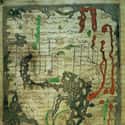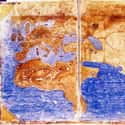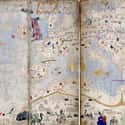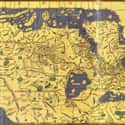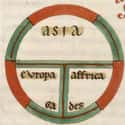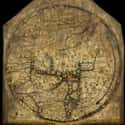-
(#5) Anglo-Saxon World Map, Circa 1025-1050
The Anglo-Saxon map, made in Canterbury between 1025 and 1050, contains the earliest known realistic depiction of the British Isles. However, it is almost unrecognizable as a world map, in part because it doesn’t follow many of the conventions of other medieval T-O style maps. Like the Tabula Peutingeriana, it recalls a Roman past by using Roman names for the provinces.
The British Isles are at the bottom left corner of the map, with Jerusalem roughly at the center, again showing the influence of religion on medieval mapmaking. As with many medieval maps, the top is east. Before the 1500s, there was no convention about putting north at the top of maps, and many placed east at the top because Europeans were convinced the biblical Earthly Paradise was in the Far East.
-
(#12) Medici-Laurentian Atlas, 1351
Some medieval maps are still recognizable today. Africa might appear a bit strange on the Medici-Laurentian Atlas map from 1351, but Europe, North Africa, and the Middle East are all remarkably accurate. That’s because the anonymous maker of this map, probably from Genoa, was trained in making portolan charts.
Portolan charts were used by sailors to navigate the Mediterranean and Black Seas. They required precise geographic knowledge so ships would not get lost. While this expensive and beautifully painted map would not have been taken out to sea, it incorporates knowledge from portolan charts. It also serves as a reminder that religious medieval maps were not produced because mapmakers lacked geographical knowledge, but because the maps served a specific purpose.
-
(#11) Catalan Atlas, 1375
In the late 1300s, the most famous mapmakers in Europe were a family of Catalonian Jews. King Charles V of France commissioned the Catalan Atlas to show the most current geographical knowledge in the world, as of 1375. The map is an artistic creation that combines portolan chart geographic knowledge with hundreds of illustrations.
On the world map, you can spot Europeans traveling the Silk Road to China; a warrior elephant with sharpened tusks; the flags of various territories; and strange birds, animals, and people. The map also paints many of the islands, such as Corsica and Sardinia, in gold. Islands were a popular topic of fascination in the late medieval and Renaissance period, and multiple mapmakers created “Isolarios,” or books of islands, that would simply contain maps of different islands. On sea charts, islands were an obstacle to navigation, but they were also linked to the notion of a territorial state.
-
(#10) Tabula Rogeriana, Circa 1154
This map is perhaps the most worldly. The Tabula Rogeriana - Latin for the Book of Roger - was created around 1154 by a Muslim scholar named Al-Idrisi. He was born in North Africa, educated in Islamic Spain, traveled across the known world, and eventually worked for Roger II, the Christian king of Sicily. In the 12th century, Sicily was heavily influenced by Byzantine, Catholic, Muslim, and Viking traditions. The Normans, former Vikings who settled in France, conquered the island’s Arab rulers and claimed it for themselves. Greeks, Romans, Byzantines, Arabs, and Normans had all claimed Sicily.
So it's no surprise that Al-Idrisi created one of the most accurate, complete maps of the known world. Al-Idrisi drew on interviews with dozens of travelers, in addition to authoritative texts.
However, the Tabula Rogeriana is also a product of its time, and the best reminder is the fact that the map places south at the top. For Al-Idrisi, the world he knew best - the Muslim territories of North Africa - was to the south, so it made sense to place it at the top.
-
(#1) T-O Map From Isidore Of Seville's 'Etymologies,' Circa 600
Many medieval world maps followed the same general style, known as the T-O map. These maps showed the three known continents in a T-shape, ringed by an O of water - sort of like the Trivial Pursuit wedge of the world. This simplified version of a medieval world map emphasizes the simple shape of the world in its lines.
Asia is shown at the top of the map, with Europe and Africa below. The Mediterranean, the Nile, and the River Don make up the water separating the continents.
This style of map, which didn’t prioritize accuracy, was meant to highlight the harmonious balance between the continents. It was also clearly a religious map: Jerusalem was at the center, and mapmakers often included religiously significant items, such as Noah’s Ark or the Earthly Paradise.
-
(#8) Hereford Mappa Mundi, Circa 1300
The Hereford mappa mundi shows what the simplified T-O structure looks like with more geographical details. This map, made around 1300, has been in England’s Hereford Cathedral for 700 years, capturing a medieval view of the world. Medieval and biblical history mingle on the map, which includes over 500 illustrations of people, animals, cities, and towns; 15 biblical events; and an array of strange creatures, odd people, and mythological images.
The variety in the Hereford mappa mundi points to its intended use: It is a visual chronicle of knowledge, mixing time and space to stun viewers with the scope of the world. And it’s no mistake that the Hereford mappa mundi is housed in a cathedral - it’s also a religious object meant to educate Christians on their place in the world.
New Random Displays Display All By Ranking
About This Tool
In the Middle Ages, people did not have map consciousness. As a new civilized world is being formed, the concept of maps that once existed in the Greco-Roman era is gradually dying out. Although some ancient Roman world maps were preserved until the early Middle Ages, they apparently disappeared as slowly as the dying classical traditions and knowledge, which also led to the production of strange maps at that time.
The knowledge and techniques of scientific mapping were not rediscovered until the 15th and 16th centuries. The random tool shows 12 weird maps of the Middle Ages that you must be interested in.
Our data comes from Ranker, If you want to participate in the ranking of items displayed on this page, please click here.











